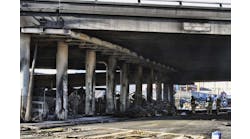When you are getting ready for a highly anticipated date, standing in front of the mirror becomes a compulsive behavior. Once in a steady relationship, you better be able to look somebody else in the eyes.
The California Department of Transportation (Caltrans) Public-Private Partnership Authority is staring at 2017 and wondering if it will be good enough. On the other side of the nation, the Virginia Department of Transportation’s Public-Private Transportation Act of 1995 is about to celebrate its 18th anniversary, and has proven that the owner, private investor and traveling public can all be compatible.
Public-private partnerships (P3s) for road and bridge projects are on the rise in the U.S., and Roads & Bridges takes a look at two programs—Caltrans and the Virginia DOT—which are in different stages of development.
Having the authority
Caltrans’ P3 Authority actually came to life in 1989, and was one of the first of its kind in the country. A couple of sub-par experiences, however, knocked the program out of Caltrans’ conscious for years until it was nursed back to health in 2009.
The S.R. 91 Express Lanes project got off the ground in the early 1990s, but one of the main components of the P3 was a non-compete clause, which was common with many of the early agreements. According to the clause, improvements could not be made to any adjacent state highway during the life of the partnership.
“Caltrans ran into problems with [the consortium] on projects it felt did not meet the non-compete requirement,” said Kome Ajise, Caltrans’ P3 program manager, told Roads & Bridges, “so that became an issue because some of the projects were deemed to be safety projects and it looked like [Caltrans] could not do safety projects with this P3 in place. There was a lot of animosity as a result of that.”
The original investor, the California Private Transportation Co.—an entity formed by subsidiaries of Peter Kiewit Sons’ Inc., Compagnie Financiere et Industrielle des Autoroutes, a French toll road company, and Granite Construction Co.—eventually sold the 10-mile, four-lane facility to Orange County, and according to Ajise the route has a net cash flow in excess of $10 million.
“The road has stayed in the black, and has been a vital element of the commute in Orange County for the last 20 years,” said Ajise. “So it has been successful.”
For one reason or another, many looked at the experience as a black eye for P3s, and Caltrans did not re-enter the marketplace until just a few years ago. The list of accomplishments is still quite small. The Presidio Parkway earned a spot on Roads & Bridges’ Top 10 Bridges list in 2011. The second phase is under construction right now and expected to be completed by 2016. The P3 allowed the project to be broken into two groups of four contracts, and the design-build method has kept it on a smooth course.
“The whole [P3] process has ways of generating innovation in ways we would not imagine,” said Ajise.
Caltrans has the P3 generator on high these days, with many of the hopeful projects set to take place in Los Angeles County. The Accelerated Regional Transportation Improvements (ARTI) project is one of the closest to the starting line. ARTI is made up of six projects, including one on S.R. 71 that involves the widening and addition of a high-occupancy vehicle (HOV) lane in each direction.
ARTI has received approval from the Los Angeles Metro Board, and Ajise said getting the local thumbs-up from politicians is the single most important element of turning a P3 endeavor into reality. Without it, the plans simply do not get off the ground, and that is the reason Caltrans’ P3 Authority scaled back its original list of potential projects from 17 to eight or nine. Going through the mounds of environmental permitting is the next big hurdle.
The I-710, I-710 Freight and High Desert Corridor, also in the Los Angeles metro area, are three other P3 projects gaining momentum. The I-710 project closes the gap to connect I-710 and I-210, and has been identified as the most important closure project in the southern California freeway system. The I-710 Freight project proposes to add two dedicated truck lanes in each direction as well as one mixed-flow lane in each direction between the ports of Los Angeles and Long Beach and S.R. 60 near downtown L.A. Several interchanges along the corridor also will be improved.
“With the 710 Freight Corridor, it’s the primary access out of the Port of Long Beach, so it is very dense with trucks,” said Ajise. “Easily those ports handle 40% of the container load coming into the U.S. The idea of building an 18-mile freight corridor is really aimed at reducing congestion.”
The High Desert Corridor will be a new 50-mile east/west expressway and possible truck toll facility between Los Angeles and San Bernardino counties. The facility will carry up to eight lanes of traffic between S.R. 14 in L.A. County and I-15 in San Bernardino County. According to Ajise, all three projects have been approved by the Los Angeles Metro Board, and both I-710 jobs are currently on the tail end of environmental permitting.
“From what we have been hearing, the [investor] interest is there,” remarked Ajise. “We had a public outreach for the ARTI last July and we had easily 300 people show up from various industries, so there was excitement about getting something done.”
By 2017 when the P3 authority is set to expire, Ajise hopes the ARTI project is on the verge of completion and at least one of the I-710 projects are into procurement.
“And we hope there will be some other smaller projects that are still going through various local board policies right now,” he said.
“By 2017, if we could show three or four projects of some measured diversity hopefully we can make a case, but then it is going to depend on the policy makers of the day to decide if they want to extend, renew or authorize permanently the use of P3s.”
Picky but productive
Virginia knows its P3 program is going to be around for a while, but it still needs to impress.
For each prospective project, an in-depth feasibility study is conducted. The department looks at cost-benefit and value-for-money analyses, and also considers the technical feasibility and complexity of the project.
“We are very selective,” Dusty Holcombe, deputy director of the Office of Transportation Public-Private Partnerships, told Roads & Bridges, “but when they do get selected and are advanced, the Commonwealth thought it would be better if specific individuals [in the Office of Transportation Public-Private Partnerships] were focused on those types of complex transactions.”
The P3 office takes it a step further when analyzing the risks. According to Holcombe, a risk workshop is held for each potential project, where they identify the risks at the technical, financial and legal level.
The process has produced positives. Rte. 288, Rte. 895 Pocahontas Parkway, and Rte. 199 are P3 projects that have been completed in recent years, and there are seven currently under construction, three under procurement and at least another nine listed as P3 candidates.
Tolling is not the only funding mechanism used, either. On the Rte. 288 project, which is currently under construction and located in Fairfax and Loudoun counties, a tax district has been set up along the corridor itself, and the taxes that are received are 75% of the revenue for the development of the project. The Coalfields Expressway project, which is Rte. 121 located in the Appalachian region, involves a partnership with two coal companies, and revenue generated from mineral reserves harvested has resulted in a 45% reduction in the cost of the project.
Of course, the gem of Virginia’s P3 effort is the Downtown Tunnel/Midtown Tunnel/MLK Extension project, which comprises the development, design, construction, finance and operation of a new two-lane tunnel parallel to the existing Midtown Tunnel under the Elizabeth River. The deal also includes the maintenance and safety improvements to the existing Midtown and Downtown tunnels, extending the MLK from London Boulevard to I-264 and interchange modifications at Brambleton Avenue and Hampton Boulevard.
“We want to create a sustainable program where we can try to identify projects and maybe get one or two or three projects out a year, whether they are small or mega projects,” said Holcombe.
As far as projects that are set to go out in future years, Holcombe likes the Rte. 460 Corridor Improvements project, the I-64 Peninsula Corridor Study and the I-66 Corridor Improvements. The 460 is tied to a 6320 corporation, which is a not-for-profit corporation that is developed as a special purpose vehicle for the project itself. It was created for this project to get toll revenue bonds, “and instead of bringing a concessionaire in, what we did is a design-build-finance where this 6320 corporation brought $380 million worth of financing to the table,” said Holcombe.
“We found that that brought the best value for that particular project because it was a Greenfield. It was in an area that in the beginning years had very low traffic volumes on it and there was a lot of risk if we would have brought the private sector in.” R&B


